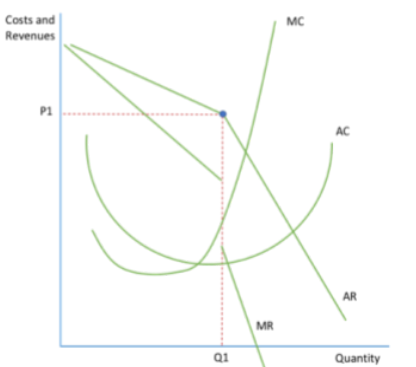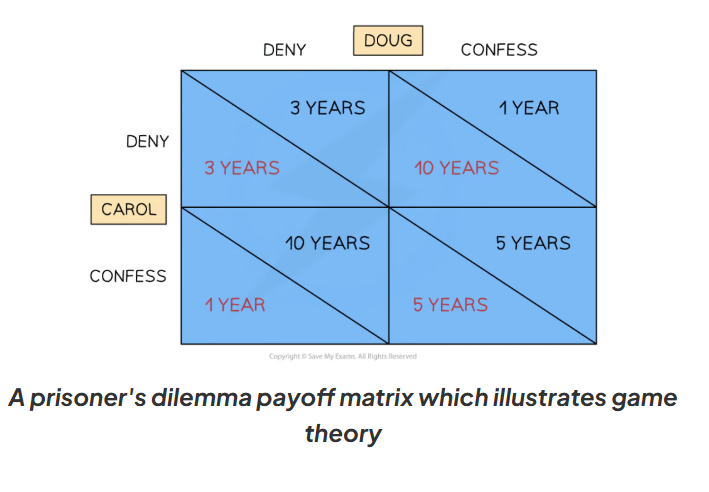3.4.4 Oligopoly
1/40
There's no tags or description
Looks like no tags are added yet.
Name | Mastery | Learn | Test | Matching | Spaced |
|---|
No study sessions yet.
41 Terms
imperfectly competitive
market structures where firms do have some market power and can influence prices
what do most imperfectly competitive industries operate in
oligopoly market structure E.g., Banks, insurance companies, department stores, supermarkets, petrol retailers, sport stores etc.
oligopoly
market structure in which a few large firms dominate the industry with each firm having significant market power
characteristics of an oligopoly market
high barriers to entry and exit
high concentration ratio
interdependent - actions of one firm will directly affect another
highly differentiated products
concentration ratio
reveals what percentage of the total market share a specific number of firms have
10-firm concentration ratio
reveals the total market share (concentration) of the top 10 firms in the industry
5-firm concentration
reveals the total market share (concentration) of the top 5 firms in the industry
when would it be considered an oligopoly
five-firm concentration ratio of around 60%
when would it be pure monopoly
one-firm concentration ratio of 100%
what do CMA define monopoly
firm with more than 25% market share,It prevents mergers or acquisitions from taking place which would give one firm more than 25% market share
how to calculate concentration ratio
identify top n firms by value of sales and value of sales together
calculate percentage of total sales that top n firms have
types of price competition
price wars
predatoy pricing
limit pricing
price wars
competitors repeatedly lower prices to undercut each other to gain or increase market share
example of using price wars
supermarkets
predatory pricing
lowering prices when a new competitor joins the industry to drive them out it is illegal as anticompetitivel
limit prices
firms set a limit on how high the price will go in the industry a lower price reduces profit and disincentives other firms from joining the industry the greater the barriers to entry the higher the limit price is likely to be as firms are already disincentivised
non price competition
competition that is not based on price
examples of non price competition
loyalty cards and rewards
branding
packaging
celebrity/influencer endorsemenet
Corporate sponsorship e.g. Nike sponsoring Rafael Nadal
After sales service
Delivery policies
Product warranties
kinked demand theory
if a firm rises it’s prices other firms will not follow wince they know their comparatively lower price means they are more competitive
however if a firm lowers its its price, other firms will follow since they want to remain competitive. Therefore, we assume price starts at P1: above P1 the curve is elastic (since competitors are offering lower prices) and below P1 the curve is inelastic (since other firms lower their prices too so there is a little difference in sales for the original firm). The result is a kink in demand. This kink in demand means that there is a gap in the MR curve and so a rise or fall in costs or demand is likely to have no impact on price or output. Because of this, prices in oligopolistic markets tend to be stable.

problem with kinked demand curve theory
does not explain how optimal price set
deals only with price competition
assumes particular reaction by rivals
firms sell multiple products
what would happen if bp raises petrol prices
rivals do nothing
bp will lose market share as customer chose alternaties
lose revenue and profit
what would happen if bp reduces petrol prices
very quick win
rivals follow with own price reduction
price war leads to loss in revenue and profits for whole market
advantage of oligopoly
competitive oligopoly can elad to price wars which then increases consumer surplus
lower prices
higher levels of research and development
can exploit internal eos which then leads to lower average costs and lower price sin long run
high supernormal profits can be taxed so revenue to help public services
disadvantagesof oligopolies
cartel behavious lesad to high er prices loss of allocative efficient and hurting low income households
high conc ratio limites consumer choice and barriers to enrty may deter innovative smaller firms from pprofitable entry
high levele of spending on branding and advertising can increase production costs passed onto consumers as higher prices
many transnational oligopolies avoid paying tax through shadow or transfer pricing leaving with lower gov revenue
collusive behaviour
occurs when firms cooperate to fix prices and restrict output
non collusive behaviour competitive
when firms actively compete to maintain/increase market share
formal collusion ovet
agreement between firms -cartel usually illegal
informal collusion tacit
happens without an agreement not in firms best interest to compete
reasons for collusion
few firms/competitors
similar costs
similar revenue
high barriers to entry
ineffective regulation
brand loyalty
consequences of overt collusion
Higher prices for consumers
Less output in the market
Poor quality products and/or customer service
Less investment in innovation
what ways does overt collusion happen
Price fixing
Setting output quotas which limit supply and naturally results in price increases
Agreements to block new firms from entering the industry
Agreements to pay suppliers the same price thereby driving down prices in the supply chain (monopsony power)
most common form of tacit collusions
price leadership or price matching
This occurs when firms monitor the price of the largest firm in the industry and then adjust their prices to match
It is difficult for regulators to prove that collusion has occurred
It provides similar benefits to firms as overt collusion, but perhaps not to the same degree
It has similar consequences for consumers as overt collusion, but perhaps not to the same degree
effect of collusion on producers
increased sales revenue and profit
increase in producer surplus
increase of non price competition
increase in ibestment in innovation and research and develoment
effect of collusion on consumers
higher price charged
reduction of consumer surplus
restricted output
increase in non price competiiont benefits customers
apple collusion example
colluded with publishers to increase ebook prices but ahd to py out 450m in court to reimburse consuemrs who were overcharged
efficiency in oligopolies
static inefficient as not productively or allocatively efficient
dynamically efficient as make supernormal profits so have funds to invest
game theory
study of how people make decisions when they are interacting with others and how their choices depend on what others do
why is game theory used in economics
to understand strategic behaviour especially in oligopolies where a few large firms dominate the market
prisoners dilemma
famous idea in game theory that shows why 2 people may not cooperate even if working together is best for both
payoff matrix
outcome of players given different possible strategies

dominant strategy
move that gives a better outcome no matter what the other player does